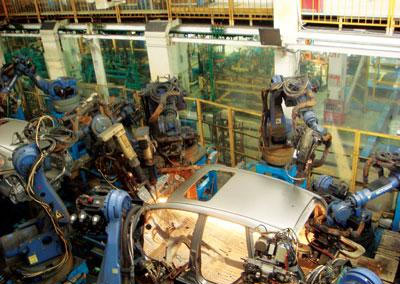Current status and development trend of welding technology in automobile manufacturing industry (2)
Application and development trend of welding materials
As the body develops toward lighter weight, the weight of the body material and the non-metallization of the body metal material are inevitable trends. Future body materials are still dominated by steel plates, but some composite materials will be widely used.
Galvanized steel sheet
With the development of the automotive industry, galvanized steel sheets are widely used in order to improve the service life of the vehicle body and enhance the corrosion resistance of the vehicle body materials. In the current automobile body manufacturing, the resistance spot welding method is mainly used. Compared with the uncoated steel sheet, there are still some problems in the spot welding process of the galvanized steel sheet: the zinc layer is melted before the steel sheet is formed, and the zinc ring is shunted, resulting in welding. The current density is reduced; the surface of the zinc layer is burned, the electrode is contaminated, and the life of the electrode is lowered; the resistivity of the zinc layer is low, the contact resistance is small; and defects such as welding spatter, cracks, and pores are easily generated.
2. High-strength steel plate
In order to achieve lightweight vehicles and improve vehicle safety performance, the application of high-strength steel sheets is increasing year by year. At present, the varieties of high-strength steel sheets mainly include phosphorus-containing cold-rolled steel sheets, bake-hardened cold-rolled steel sheets, and cold-rolled dual-phase steel sheets.
(1) High-strength cold-rolled steel sheets containing phosphorus: high strength, good strength and plastic balance, good corrosion resistance and spot welding performance; mainly used for side panels, doors, canopies and trunk lids.
(2) Bake-hardening cold-rolled steel sheet: This bake-hardened steel sheet, which is abbreviated as BH steel sheet, is both thin and has sufficient strength, and is one of the preferred materials for lightweight design of body panels.
(3) Cold-rolled dual-phase steel sheets: mainly used for bearing parts with good tensile properties, such as door reinforcement plates and bumpers.
3. Aluminum alloy
Compared with automotive steel sheets, aluminum alloys have the advantages of low density, high specific strength, corrosion resistance, good thermal stability, easy forming and recyclability, and the technology is mature. Parts of aluminum alloy materials are also gradually being used in the automotive industry. However, aluminum alloy welding still has the disadvantages of large linear expansion coefficient, large thermal stress, and easy occurrence of pores, which leads to a decrease in the strength of the aluminum alloy welded joint.
4. Magnesium alloy
The density of magnesium is only 35% of the density of the steel. It has high specific strength, high specific stiffness, good damping and thermal conductivity, and good dimensional stability. Therefore, it has been widely used in the automotive industry. At present, magnesium alloys are mainly used in door casting in the automotive industry. With the advancement of die casting technology, thin-walled magnesium alloy body parts such as front/rear baffles, instrument panels and steering wheels can be manufactured.
5. High-strength fiber composite
In the late 1980s, composite body panels were widely used and promoted, such as hoods, fenders, doors and canopies, and even full-composite car bodies. Composite materials are used as exterior parts for automobile bodies, and they have matured from design to manufacturing and application, and have been developed from the use of outer coverings to interior parts and structural parts.
New materials and new processes are complementary, and the automotive industry is developing new manufacturing methods and updating traditional processes. According to relevant predictions, in the next 10 years, the quality of the car itself will be reduced by 20%. In addition to the large number of composite materials and lightweight alloys, the body design method will also undergo major changes.
Application of welding robot technology
The mass production, high efficiency and consistency of product quality of automobile manufacturing have made the robot production method widely used in automobile welding. The welding robot is a welding device with independent body, high degree of freedom of operation, flexible program change, high degree of automation and high degree of flexibility. With high repeatability, good welding quality, fast moving speed and stable and reliable operation, welding robot is the best choice for flexible welding equipment. As an important part of the welding production line, welding equipment is one of the important signs of the flexibility of the welding production line. Figure 2 is a partial view of the Guangzhou Honda robot welding production line.

Previous Next
Channel Drain Shower,Tile Insert Square Channel Drain,Anti Odor Stainless Steel Shower Drains,Tile Insert Adjustable Shower
Kaiping City Jinqiang Hardware Products Co.,Ltd , https://www.jqfloordrain.com